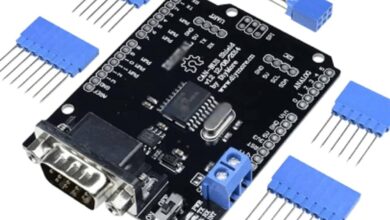Facts You Need to Know about Automotive Oscillators

Are you eager to unveil the concealed heartbeat of your car? It’s time to reveal the unsung hero of the engine – automotive oscillators! These diminutive yet powerful devices actively ensure the smooth and efficient operation of your vehicle. In this article, we will delve into the captivating realm of automotive oscillators, demystifying their internal mechanisms and examining why these modest components warrant greater consideration. Strap in, as we initiate a thrilling journey through the essential facts about automotive oscillators!
How Do Automotive Oscillators Work?
Automotive oscillators are pivotal in modern vehicles, generating precise electrical signals through a circuit that produces repetitive waveforms. They typically feature a feedback network and an amplifying element, often a transistor or integrated circuit, to sustain oscillation.
At the core lies a quartz crystal resonator, activated by applying voltage. The crystal vibrates at its natural frequency due to the piezoelectric effect, producing highly stable and accurate electrical signals. When power is supplied, the crystal vibrates, and the resulting signal is amplified for use in various vehicle systems like engine management and ignition timing control.
Advancements offer different types, from fixed-frequency to variable-frequency oscillators, catering to specific purposes in diverse vehicle systems. Understanding their working principle highlights their crucial role in enhancing overall performance and efficiency on today’s roads.
Types of Automotive Oscillators
In the realm of automotive oscillators, diversity reigns with distinct types serving specific roles:
1. Quartz Crystal Oscillator
The precision maestro conducted the orchestra with remarkable accuracy using the piezoelectric dance of quartz crystals. From timing systems to fuel injection, it maintains harmony in modern vehicles.
2. RC Oscillator
A classic performer relying on resistors and capacitors. While not as high-fidelity as quartz crystal, it’s reliable for simpler tasks like clock circuits or low-frequency modulation in vintage models, adding a touch of nostalgia.
3. Voltage-Controlled Oscillator (VCO)
A versatile virtuoso adjusting frequencies based on input voltage, resembling a soloist capable of adapting its tune. Ideal for advanced vehicle features like radar systems or communication modules, it introduces a dynamic element.
4. Temperature-Compensated Crystal Oscillator (TCXO)
The temperature maestro countering temperature variations, crucial for stability in critical systems like GPS receivers or engine control units. Ensures accuracy even when environmental temperature plays its tune.
This oscillator diversity mirrors a range of musical instruments, each contributing to overall harmony. Engineers and enthusiasts must grasp the strengths and nuances of each type, selecting the right instrument for a well-tuned driving experience. It’s the art of choosing components to compose the perfect symphony within a vehicle’s electrical system.
Importance of Oscillators in Vehicles
Automotive oscillators, often overlooked, play a vital role in your vehicle’s functionality. These small devices generate and maintain precise frequencies crucial for various systems.
1. Timekeeping Maestros
Automotive oscillators act as time conductors, ensuring clock accuracy and synchronized timers within your vehicle, preventing lateness or missed appointments.
2. Fuel Injection Choreographers
Central to fuel efficiency, these oscillators provide precise timing signals to fuel injection systems, optimizing fuel flow into the engine for improved efficiency, reduced emissions, and cost savings.
3. Communication Virtuosos
Responsible for uninterrupted signals in hands-free calls and music streaming, automotive oscillators ensure stable frequency generation for seamless Bluetooth and wireless connectivity, enhancing the driving experience.
4. Safety Guardians
In emergency braking situations, oscillators support anti-lock braking systems (ABS), offering precise control for enhanced stability and safety, and acting as reliable partners in challenging driving conditions.
In the intricate dance of automotive functionality, these oscillators are the choreographers, ensuring every move is in sync. Though not in the spotlight, their role is indispensable, quietly making drives smoother, safer, and more connected. Cheers to the automotive oscillators!
Common Issues with Automotive Oscillators
Automotive oscillators, vital for vehicle functioning, may face issues like any mechanical component. Recognizing these common problems aids in more effective diagnosis and resolution by vehicle owners and mechanics.
Frequency Instability
It’s like the orchestra going slightly out of tune. Factors like temperature changes or component ageing can cause the oscillator to play a different frequency than intended. This can throw off the harmony in various electronic systems, affecting accuracy and functionality.
Phase Noise Troubles
Picture a radio signal with static. Excessive phase noise is like interference disrupting the clear signal. In vehicles, this can impact communication systems, potentially causing glitches in GPS navigation or hindering wireless connectivity.
Power Supply Noise Coupling
Imagine a power surge disrupting your computer. Noise from the vehicle’s power source can interfere with the oscillator, leading to distorted signals or erratic behaviour. Proper shielding and grounding become the armour against this electronic interference.
Mechanical Shock and Vibration Woes
As if the conductor’s podium is shaky, mechanical shocks and vibrations can take a toll on the delicate components of the oscillator. This wear and tear over time can lead to malfunctions or, in extreme cases, a complete breakdown of the oscillator’s performance.
Maintenance becomes the key here, like tuning instruments before a performance. Regular checks, ensuring clean connections, and inspecting for any signs of wear can prevent these issues from becoming a symphony of malfunctions in your vehicle.
Tips for Maintaining and Repairing Automotive Oscillators
Maintaining and repairing automotive oscillators involves crucial tips for ensuring their longevity and optimal performance.
Regular Visual Inspections
- It’s like tuning your instrument before a performance. Check for signs of wear, frayed wires, or any loose connections. Early detection can prevent minor issues from crescendoing into major malfunctions.
Gentle Cleaning Sessions
- Think of it as giving your oscillator a spa day. Dust and debris can disrupt the flow, affecting performance. A gentle touch with compressed air or a soft brush helps keep things clean, ensuring your oscillator operates smoothly.
Temperature TLC:
- Oscillators are like delicate instruments that can be sensitive to temperature extremes. Shield them from prolonged exposure to excessive heat or cold to prevent potential damage. It’s like providing the perfect climate for your musical instruments to thrive.
Professional Repairs:
- When your oscillator hits a sour note, consult a professional mechanic. Attempting DIY fixes without the right knowledge can be like playing a tune without knowing the notes. Professionals have the expertise to diagnose and repair issues, ensuring a harmonious performance.
Stay in Tune with the Guidelines
- Just like following the sheet music, stay updated with manufacturer guidelines and recommended maintenance schedules. This ensures that you’re in sync with the best practices for keeping your automotive oscillators in optimal condition.
Incorporate these tips into your vehicle care routine to conduct a symphony of care for your automotive oscillators, maintaining the right tempo and ensuring smooth performance. Your vehicle’s electronic orchestra will thank you with reliable and efficient operation on the road.
Future Developments and Innovations in the World of Automotive Oscillators
The future of automotive oscillators promises exciting innovations and progress, characterized by several key advancements:
Miniaturization Marvels
- As vehicles become smaller, there is a growing demand for compact yet powerful oscillators. These miniaturized oscillators are designed to fit into the limited spaces of modern vehicles without compromising on functionality, akin to composing a musical piece with fewer instruments while maintaining performance.
Digital Signal Processing Prowess
- Future automotive oscillators will incorporate advanced digital signal processing techniques, allowing them to adapt their tune based on real-time data. This dynamic performance optimization enhances accuracy and stability, resembling a conductor adjusting tempo based on the audience’s mood.
Durability and Reliability Reinforcement
- Recognizing the challenges of the automotive environment with vibrations and harsh conditions, future oscillators aim to be resilient performers. These enhancements in durability and reliability enable them to handle the rigours of the road without missing a beat, akin to seasoned musicians.
Energy-Efficient Virtuosos
- Sustainability takes centre stage as future oscillators target energy efficiency, consuming minimal power while delivering high-quality signals. This energy-efficient performance contributes to a greener and more sustainable automotive industry, akin to a performer captivating the audience with minimal energy consumption.



